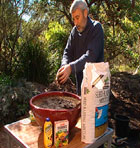There is a free packet of Yates Italian herb mix seeds attached to the August issue of the Burke’s Backyard Magazine. Inside the packet, you’ll find seeds of flat-leaf parsley (Petroselinum crispum var. neapolitanum), rocket (Eruca sativa) and basil (Ocimum spp. and cvs.). If you live in the warm areas of Australia you can sow the seeds right now, but in cooler areas wait a few more weeks until all danger of frost has passed.
The seeds
Basil
goes well with tomato flavours. There’s a wide variety of basils to choose from, showing different leaf shapes and colours. In our Yates seed packet we have included several basils, including the most popular one (sweet basil, the favourite of Italian cuisine) as well as lemon basil, bush basil and colourful purple basil.
Flat-leaf parsley
(also called Italian or continental parsley) is found in countless dishes ranging from pasta sauces to soups, stews and salads. Italian parsley has a stronger flavour than the curly-leaf parsley.
Rocket
also goes by the common names of arugula and roquette. It is a fabulous first plant for beginners to grow from seed, because it’s a fast-grower that’s well named. Rocket seeds sprout and grow very quickly indeed, so you should be harvesting this nutty, spicy salad treat in just a few weeks!
Pot them up
All three plants are well suited to growing in pots, so they’re beaut choices for a balcony or courtyard garden.
As a rule, when growing herbs and vegies in pots the bigger the pot the better, because the potting mix is less likely to dry out.
Check the pot to make sure it has enough drainage holes in the bottom. If necessary drill extra holes using a masonry drill bit.
It is a good idea to raise the pots slightly above the ground. This improves drainage, stops plant roots growing through the drainage holes and minimises staining to the balcony. Pot feet or bricks work well.
You can sow straight into potting mix, but you will get a better germination rate using a layer of seed raising mix on top.
For best results, mix some slow release fertiliser, such as Osmocote, into the potting mix. Herbs taste best when they are grown and harvested quickly, and the fertiliser keeps them powering along.
Never use a cheap potting mix. Quality potting mixes display the Standards Australia ‘ticks’ on the pack.
Growing tips
Once your pot is ready and filled with potting mix, you are ready to sow.
All three herb seeds come mixed together in the packet, and there’s enough for several crops, so we suggest you scatter just a small portion of seed widely and lightly with each sowing, to avoid overcrowding.
Cover the seeds lightly with 2-3mm of seed raising mix, firm down and keep moist until after germination.
It’s easy to tell which seed is which: the rocket will appear in days, then a week later the basil, and the parsley will sprout last. If necessary, thin out seedlings when about 5cm high, so they stand 15-20cm apart.
Keep well watered while establishing and feed about once a fortnight with a liquid fertiliser, such as Thrive or Nitrosol.
Costs
Ceramic pots are available from nurseries and garden centres. The one Don used in our segment cost approx. $70.
30 litres of good quality potting mix, about $10-$18.
Good quality seed raising mix, about $10-$15.
1 kg controlled release fertiliser, such as Osmocote, costs about $10.
500ml liquid fertiliser costs around $8.
Further information
The August 2004 edition of the Burke’s Backyard Magazine, including free Italian herb mix seeds, is available at newsagents and supermarkets for $5.70.



